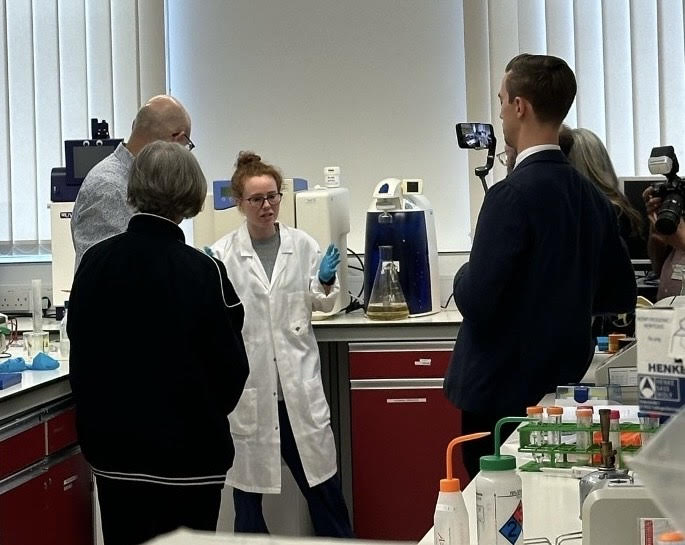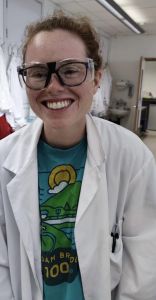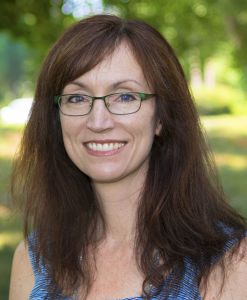How a Creative Chemistry Lab Shaped This Graduate’s DNA-Decoding Protein Research

When Dr. Katherine Albanese was a member of the Waters Lab at UNC, one of her main projects was engineering proteins that can detect a specific chemical tag on other proteins called methylated lysine. This helped set the stage for how her lab now designs new proteins to study how genes are turned on or off.
July 10, 2025 | By Dave DeFusco
In her lab at Wake Forest University, Assistant Professor Katherine Albanese is reimagining proteins as tools for probing life at the molecular level—decoding how subtle chemical tags on DNA-packaging proteins affect gene expression and, ultimately, health.
It’s a mission shaped as much by her academic journey as by her scientific imagination. Albanese’s lab at Wake Forest is a reflection of the interdisciplinary rigor, collaborative spirit and experimental freedom she experienced during her Ph.D. at the University of North Carolina at Chapel Hill, where she trained in the lab of Dr. Marcey Waters, Glen H. Elder, Jr. Distinguished Professor of Chemistry.
“I’m extremely grateful for the latitude Marcey gave us to explore our own ideas,” said Albanese. “We planned our projects from start to end, and when things didn’t work, we came up with new hypotheses for why. That ability to shape and reshape a problem has stuck with me.”

Albanese’s research today focuses on epigenetics—how gene activity is controlled by reversible chemical tags on histone proteins. These posttranslational modifications, or PTMs, can turn genes on or off without changing the underlying DNA. The proteins that “read” these modifications are critical for maintaining healthy cell function. Misreading them, as occurs in many cancers, can lead to disease.
Understanding these readers, however, is no small feat. Histones are notoriously disordered proteins, meaning they don’t hold a rigid structure—a feature that challenges conventional protein design tools, which rely on well-defined shapes like helices and sheets.
“The hardest part is designing something to bind to a protein that doesn’t have structure,” she said. “We’re tweaking current computational pipelines to accept sequence inputs instead of structure. It’s a very different problem.”
This kind of challenge—engineering “reader proteins” that can selectively recognize these shapeshifting signals—grew out of her work in the Waters Lab, where she investigated how proteins interact with methylated lysine, a common histone modification.
When Albanese joined Waters’ group at UNC in 2016, the lab was shifting from studying small molecule receptors to investigating full proteins with biological relevance. It was a pivotal time, and Albanese, along with a small cohort of graduate students, helped shape the lab’s new research focus.
“Katherine was fearless in blazing new directions in my lab,” said Waters. “My research program wouldn’t be where it is today without her leading us all in a new direction. I’m excited to see where she takes her own research program. I definitely feel like a proud parent!”
Albanese said they spent a lot of time bouncing ideas around and exploring possibilities together. “Marcey was always encouraging. Even if I had a wild idea, she never said, ‘No, that’s bad.’ It was always, ‘Let’s talk through it.’”

One of her main projects was engineering proteins that can detect a specific chemical tag on other proteins called methylated lysine. This helped set the stage for how her lab now designs new proteins to study how genes are turned on or off. The experience also introduced her to high-level interdisciplinary collaborations with leaders like Ken Houk and Brian Kuhlman that continue to shape her philosophy today.
“Science is better when you bring more people to the table,” she said. “That’s something I carry into how I run my lab now. I’m always looking for new collaborators at Wake or in the surrounding area.”
During her postdoctoral fellowship at the University of Bristol in the UK with Professor Dek Woolfson, Albanese immersed herself in computational protein design, helping develop α-helical barrels, which are cylindrical protein structures built with precision. While her current work doesn’t use these barrels directly, the philosophy of “rational seeding” lives on.
“Rather than letting AI spit out a protein for us, we use our intuition—what we know about molecular recognition—and build from that,” she said.
In her own lab, this looks like identifying a key feature, such as an aromatic cage known to recognize methylated lysine, and using it as a starting point to design new proteins from scratch. These proteins become experimental tools for uncovering how histone modifications work, and how mutations may disrupt their function.
Now, as a faculty member at her alma mater, Albanese teaches courses in biochemistry and protein design that mirror the creativity and structure of her own scientific path. In one graduate seminar on protein design, students analyze scientific literature, build proteins computationally, and propose their own experimental projects.
“The goal is for students to understand how protein sequence relates to structure and function,” she said. “That way, when they build something from scratch, they really appreciate the nuances.”
In her undergraduate biochemistry lab, students study enzymes like beta-galactosidase—the same enzyme found in lactose pills. “I love when students realize, ‘Oh, this thing I bought at the pharmacy? I now understand how it works.’ That kind of moment makes biochemistry come alive.”
Her teaching style—open-door and supportive, but hands-off when needed—draws directly from her time at UNC. “I try to be hands-off for students who want to explore, and very present for students who want direct input. That balance was something I really valued in Marcey’s lab.”
Though she now leads her own lab just an hour away from Chapel Hill, she still stops by when she can. “I’m grateful to still have Marcey nearby,” she said. “It feels like coming full circle by bringing that spirit of exploration forward.”

